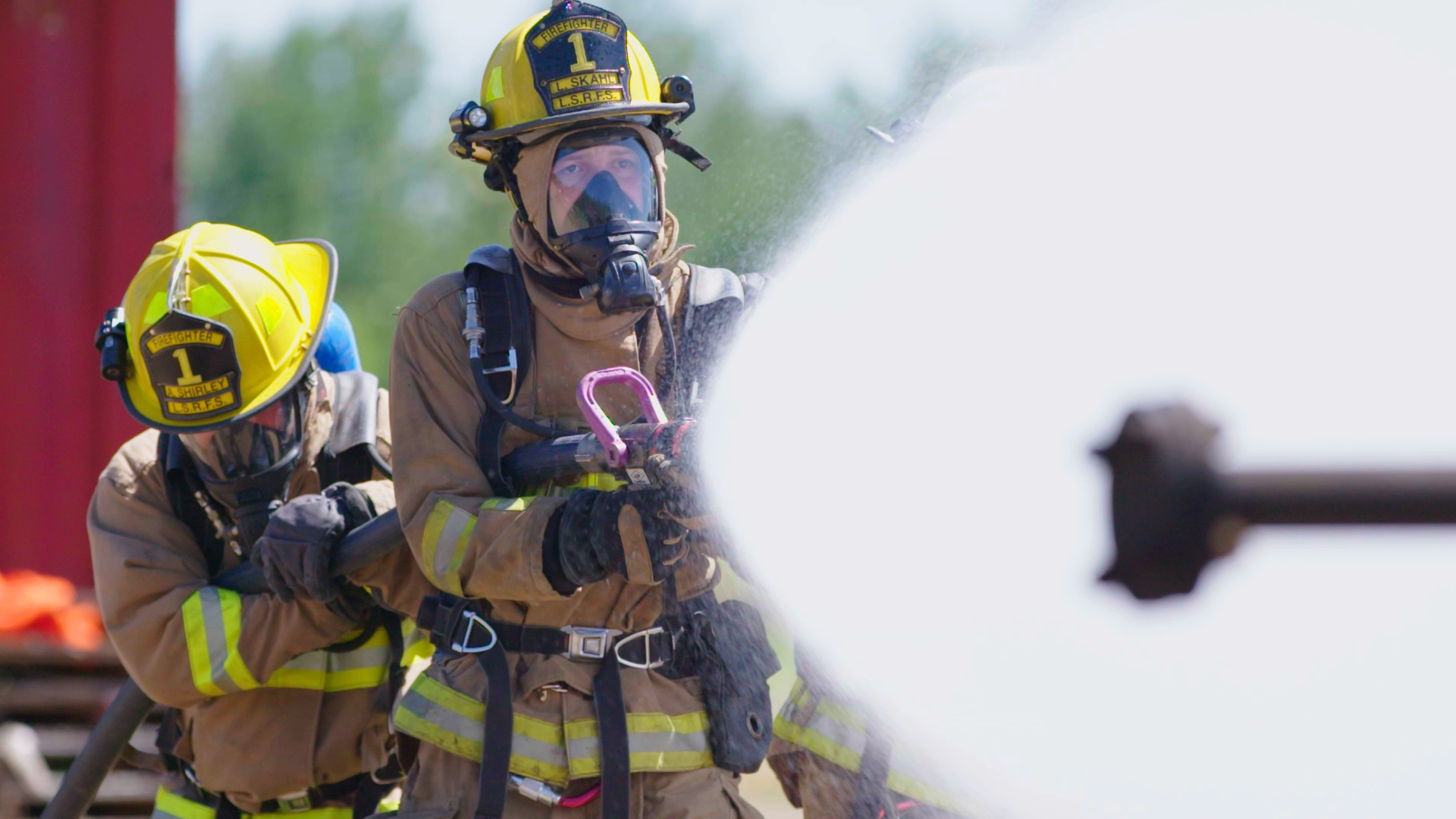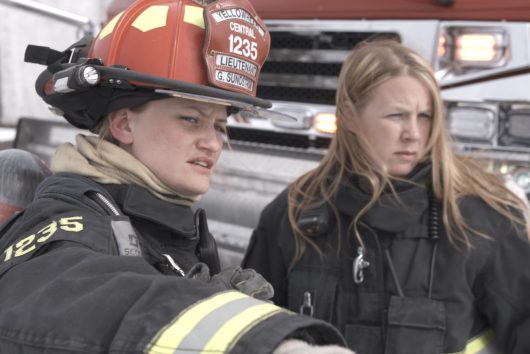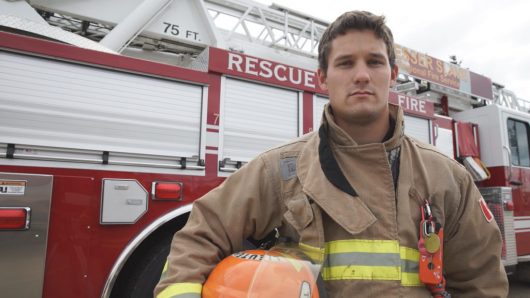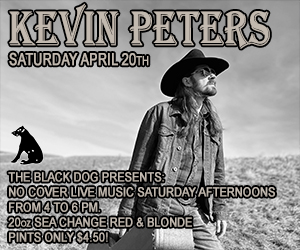TV: Raise a little Hellfire Heroes
Posted on May 19, 2018 By Mike Ross culture, Entertainment, Front Slider, TV and Radio
 It makes sense that what may be Canada’s first firefighter reality show is set in Alberta. Lord knows the province has suffered trials by fire.
It makes sense that what may be Canada’s first firefighter reality show is set in Alberta. Lord knows the province has suffered trials by fire.
Hellfire Heroes, an eight-show documentary series (don’t call it a reality show) premiering May 22 on Discovery Canada, follows teams of firefighters working in two rural Alberta communities. With more than 32,000 square km of territory between then, the Lesser Slave Regional Fire Service and the Yellowhead County Fire Department tackle almost everything from stuck cats to search and rescues, to flaming highway wrecks to forest fires, and often have to drive long distances at high speeds to respond. Never a dull moment.
 In the first episode, the film crew rides along on several emergency calls – including a dangerous structure fire near Slave Lake where the rookie Patrick McConnell has a tense moment inside the burning house. In Yellowhead County, meanwhile, a woman in labour and her husband rushing to the hospital hit a deer on the highway. They’re OK, but the car is wrecked – and the baby won’t wait. The battle-worthy fire crew nervously rushes to respond to what would be their first baby delivery, and relieved they get beat to the scene by the paramedics. Everybody’s fine.
In the first episode, the film crew rides along on several emergency calls – including a dangerous structure fire near Slave Lake where the rookie Patrick McConnell has a tense moment inside the burning house. In Yellowhead County, meanwhile, a woman in labour and her husband rushing to the hospital hit a deer on the highway. They’re OK, but the car is wrecked – and the baby won’t wait. The battle-worthy fire crew nervously rushes to respond to what would be their first baby delivery, and relieved they get beat to the scene by the paramedics. Everybody’s fine.
Back in Slave Lake, after a three hour battle where they almost run out of water, the house fire is finally extinguished. No one is injured, but the poor woman lost almost everything except a few keepsakes and photos that were saved. “There’s been a lot a lot of times I’ve seen people lose everything,” says deputy chief Alex Pavcek. “It takes its toll on you after a while, so anything you can give back to a homeowner, you’ve done a good job.”
“Oh, well,” the elderly woman sighs, clutching a singed picture to her chest.
 This is high level human drama. You might wonder why this hasn’t been done so much before. They’ve done cops, doctors, loggers, truckers, bush pilots and crab fisherman, but rarely have firefighters been put under the spotlight to this extent. Imagine having job where you have to be a hero every day.
This is high level human drama. You might wonder why this hasn’t been done so much before. They’ve done cops, doctors, loggers, truckers, bush pilots and crab fisherman, but rarely have firefighters been put under the spotlight to this extent. Imagine having job where you have to be a hero every day.
Montreal producer Nicola Merola – who’s worked on past Discovery shows like Fort Mac Wildfire: Rogue Earth, and License to Drill – says there were a number of reasons why they chose Alberta, not the least of which were the terrible fires that devastated Fort McMurray in 2016, and Slave Lake in 2011, both still on the minds of so many Canadians.
Merola says, “In Slave Lake in 2011 when the fire happened, it’s something that shaped – I think I can say that – something that shaped the Slave Lake fire department the way it is now – and that also made following that team a very interesting thing to follow.”
 We meet Slave Lake fire chief Jamie Coutts, and his deputy Pavcek, along with members of the crew like the aforementioned rookie McConnell (right) – who wound up being the guy to finally snuff the structure fire from inside. It was his first time going inside. In Yellowhead and Edson, meanwhile, the action revolves around chief Albert Bahri and his crew, including Gabriella Sundstrom. They deal with the call for the woman in labour. Each week’s episode focuses on at least three typical – typically dangerous and life-threatening – emergency calls split between the two jurisdictions. You get to know these brave men and women in the process.
We meet Slave Lake fire chief Jamie Coutts, and his deputy Pavcek, along with members of the crew like the aforementioned rookie McConnell (right) – who wound up being the guy to finally snuff the structure fire from inside. It was his first time going inside. In Yellowhead and Edson, meanwhile, the action revolves around chief Albert Bahri and his crew, including Gabriella Sundstrom. They deal with the call for the woman in labour. Each week’s episode focuses on at least three typical – typically dangerous and life-threatening – emergency calls split between the two jurisdictions. You get to know these brave men and women in the process.
“They get a lot of calls,” Merola says. “They get a lot of variety of calls, which is important for this kind of show, and they cover a huge territory.”
It’s dangerous work – for both fire and film crews. Merola and his camera units had to undergo two weeks of basic training before they were allowed to follow the firefighters around in such close quarters. This included wearing a mask and oxygen tanks while they literally stood inside a burning building. They had to develop a trust with their subjects.
“I’ve done many of these series for the past 12 to 15 years,” Merola says. “There’s one thing we will always respect: When the people who we are photographing, when they say stop here, we stop. For the security of the crews. And if we don’t respect the way these guys work, they’re going to kick us out – and we don’t want to be kicked out.”
 That doesn’t keep the filmmakers from getting some hair-raising shots: Bursts of flame, collapsing ceilings, terrible highway wrecks, scrambling around in dark and smoke, or vistas from the safety of aerial drone shots (much cheaper than helicopters).
That doesn’t keep the filmmakers from getting some hair-raising shots: Bursts of flame, collapsing ceilings, terrible highway wrecks, scrambling around in dark and smoke, or vistas from the safety of aerial drone shots (much cheaper than helicopters).
This producer definitely has a passion for his subject matter.
He says, “I think there are so many people in Canada that do unbelievable things and we don’t hear about it, we don’t talk about it, and we never see it in a way that is specific or personal like this. It’s not easy what they do, to wear that gear, to use those tools and it’s extremely demanding physically. They really do risk their lives, and they really do breathe bad stuff, stuff that is not good for their health, but they do it to save other people’s lives. It’s pretty unbelievable. I’m not sure I would have that guts to do that for a living. The show is in a large part a celebration of that.”













